
Finger lime: planting, growing and harvesting
Contents
Finger lime essentials
- Finger lime is a surprising and sought-after Australian citrus that produces original, elongated fruits
- They contain small tangy pearls that resemble caviar in appearance
- Its fruits are highly prized in cooking for their unique lemony flavour
- It flowers in spring with small, discreet, scented flowers
- It prefers free-draining, fertile, slightly acidic soils
- It needs protecting from cold in winter
- It is a compact, dense and thorny bush, perfect in a pot
A word from our expert
Finger lime is an Australian citrus producing cylindrical fruits filled with small tangy pearls, green, yellow or pink. It forms a dense, thorny bush up to 3 m tall, with green foliage and unobtrusive but fragrant spring flowering. Highly prized in cooking, its fruits offer a unique citrus flavour.
Quite tender, it tolerates brief frosts down to −5 °C, but must be brought indoors for winter away from frost, unless grown in a mild climate. It prefers rich, well-drained, lime-free soil in full sun or partial shade.
Finger lime (caviar lime) in details
Botanical data
- Latin name Citrus australasica
- Family Rutaceae
- Common name Caviar lime
- Flowering around May
- Height up to 3–4 metres
- Exposure full sun or partial shade
- Soil type rich, fertile, well-drained, not calcareous
- Hardiness between -5°C and -2°C
Description and botany
Finger lime or Citrus australasica, is a citrus tree prized for its cylindrical fruits that contain small, zesty beads resembling caviar. In the wild, it is found in the humid forests of Australia’s east coast. It can grow in temperate or tropical climates but is sensitive to cold. It tolerates light frosts down to −5 °C if brief, but cannot withstand prolonged cold. Therefore, except in Mediterranean regions, it is better grown in a pot so it can be brought under cover for winter.
Previously, the scientific name of the finger lime was Microcitrus australasica. It is now placed in the genus Citrus, alongside lemon and orange trees, and thus bears the name Citrus australasica. The species name refers to its country of origin, Australia. In English it is called “finger lime”, a reference to its slender, elongated shape.
Like other citrus trees, the finger lime belongs to the family Rutaceae, which comprises 1,730 species. Many plants in this family contain essential oils in their tissues, giving them a characteristic scent. Besides citrus, this family includes Rue (Ruta graveolens), Sichuan pepper (Zanthoxylum), Choisya and Skimmia.
The finger lime is a densely bushy bush with fine, fairly flexible branches. It grows slowly and a young plant takes several years to produce its first fruits. In the wild, the finger lime reaches 7–8 metres at most, but in cultivation it rarely exceeds 3 metres. Stems and branches bear small green thorns, inserted in the axil of the leaves.
The finger lime produces an inconspicuous flowering in spring. Its pink flower buds open to small white or pale-pink flowers, measuring between 1 and 1.4 cm in diameter. They consist of three petals surrounding a cluster of yellow stamens (male organs bearing pollen), and a style (female organ that receives pollen). Flowers emit a delicate fragrance.

Flowers and leaves of the finger lime (photos: Forest and Kim Starr / Nadia Talent)
The finger lime has smaller leaves than other citrus trees. They reach up to 5 cm in length. Leaves are dark glossy green, ovate in shape, with a crenate lamina at the leaf tip. When crushed, leaves release a pleasant scent due to translucent glands that contain essential oils (as with many citrus trees!). Leaves are evergreen and alternate, inserted one after the other along the stem. At the base of each leaf there is also a small thorn.
Finger lime fruits are harvested between October and March. They take quite a long time to form and ripen. When ripe, they detach easily from the tree. Do not wait for them to become soft and fall naturally, as this can damage them. The fruit skin is delicate and easily shows scars or marks if bumped.

Finger lime fruits can take a variety of hues, and contain small translucent beads with a lemony taste
Finger lime fruits are not spherical like oranges and grapefruits but are long and narrow, cylindrical, which is why they are nicknamed “finger lime”, their shape evoking a finger. They do not exceed 10 cm in length and 1.4 cm in diameter. The fruit skin can display various colours: green, yellow, red, orange, brown, purple, black… The small beads inside are translucent and may be bright green, yellow or pink. They resemble fish eggs (fish roe), which gave rise to the “caviar” nickname for the fruit. These fruits are prized by top chefs. The bead texture is very pleasant in the mouth; when bitten they release a lemony, tangy flavour. Fruits are rich in vitamin C.
Discover other Microcitrus - Finger Lime
View all →Available in 3 sizes
Available in 1 sizes
Available in 1 sizes
Finger lime varieties
Most popular varieties
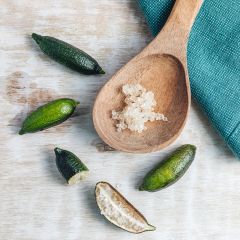
Finger Lime - Microcitrus australasica
- Flowering time April, May
- Height at maturity 3 m
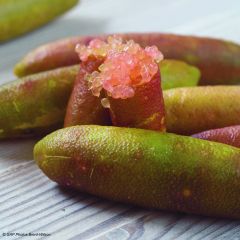
Finger lime green pearls - Microcitrus australasica
- Flowering time April, May
- Height at maturity 3 m
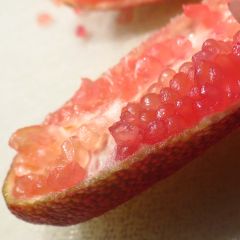
Red Crystal Finger Lime with red pearls - Microcitrus australasica
- Flowering time April, May
- Height at maturity 3 m
Read also
Citrus trees: planting and maintenancePlanting
Where to plant?
Caviar lime prefers sun or partial shade, in a spot sheltered from wind. It likes rich, fertile, well‑draining, slightly acidic soils. Avoid calcareous or waterlogged ground. In Mediterranean regions, it can be planted in the ground. Elsewhere, better to grow in a pot and bring indoors for winter, as it cannot withstand prolonged cold (limit: –2 to –5 °C).
When to plant?
Preferably in spring, around May.
How to plant?
For planting in a pot:
- Choose a pot with drainage holes in base (terracotta, wood or plastic)
- Place a drainage layer (gravel or clay pebbles) at the bottom
- Prepare a mix: potting compost + garden soil (non‑calcareous) + coarse sand
- Plant caviar lime without burying the collar
- Backfill with potting mix around the rootball and firm lightly
- Water thoroughly
- Place pot in a sunny, sheltered spot
Find out more in our care sheet: How to grow a caviar lime in a pot?

Leaves and flowers of caviar lime, Citrus australasica (photo Forest and Kim Starr)
Care
Watering
Finger lime needs a fresh substrate and regular watering from spring to autumn.
- Wait for the surface of the substrate to dry before watering again
- Preferably use rainwater
- Reduce watering in winter
- Do not let water stagnate in the saucer: raise the pot on gravel if necessary
Fertiliser
- Apply fertiliser regularly from spring to autumn
- Liquid fertiliser: every two weeks
- Slow-release fertiliser: twice a year, incorporated into the substrate
Overwintering finger lime
- Bring the bush indoors in winter into a bright, frost-free and unheated shelter (maximum temperature: 10 °C)
- Take it back outside in spring
→ For more information, see our advice sheet on overwintering citrus trees.
Repotting
- Repot every year or every two years, at the start of spring, into a slightly larger pot
- If no repotting: perform topdressing to renew the substrate surface
Pruning
- Prune in March–April: remove dead branches, open up the centre, cut misplaced shoots
- Wear covering clothing and gloves because of the thorns
Parasitic pests and diseases
-
Few parasitic pests known to date, but scale insects and aphids may appear
→ See Diseases and parasitic pests of finger lime for more information
When should caviar limes be harvested?
Caviar lime bears fruit from October–November to March. Do not wait for the fruits to fall from the tree before picking them, as they are sensitive to knocks and could become damaged.
Caviar limes are usually picked at full ripeness, when they have reached their final colour (green, yellow, pink or red depending on the variety) and are slightly soft to the touch.
A good indicator: fruits come away easily from the bush. Inside, the little pearls should be juicy and aromatic. However, fruit size does not necessarily indicate ripeness, since ripe fruits can remain small. Watch out for thorns when harvesting them.
Storage
Caviar lime can be stored in the refrigerator for up to 2 to 3 weeks, or longer in the freezer, entire or as pearls (place pearls in an ice cube tray; they retain their texture and flavour well).
Finger lime in the kitchen: which recipes?
How to savour it?
Caviar lime is best enjoyed fresh, immediately after opening. Simply cut it in half lengthways (like a small cucumber), then gently squeeze or scrape to release the small juicy pearls. These pearls burst in the mouth with an intensely lemony flavour. Always add it at the last moment, to preserve its crunch and freshness.
What to do with caviar lime?
You can incorporate the fruit into savoury dishes or desserts. Pearls are very decorative and add an original touch to dishes. Caviar lime brings a tangy, refined touch that wonderfully enhances many dishes. In cooking, it can be slipped into a salmon tartare to give it a kick, is added just before serving on oysters or sashimi, or pairs subtly with a dessert, such as white chocolate mousse, a fruit salad or an exotic tart. Its unique texture of tiny, bursting pearls also makes it perfect for decorating and surprising diners.
They can also liven up drinks or cocktails. It is also possible to dry the bark to use as a spice and flavour dishes.
Multiplication
Grafting remains the most effective method to propagate finger lime. It produces vigorous young plants true to the scion, which bear fruit in just a few years (around 3 years). For this, perform a cleft graft, preferably on a rootstock such as Poncirus trifoliata, valued for its hardiness.
Sowing finger lime is also possible, but results are unpredictable and require patience: fruiting can take more than 10 years! Use fresh seeds, taken from a ripe fruit, simply rinsed and sown immediately in a light, free-draining substrate. Keep in a warm, well-lit place, maintaining the compost slightly moist.
Propagation by cuttings is another option, although it remains slow and uncertain. Take a 15 cm finger lime cutting from a woody shoot, keeping only upper leaves. Plant it in a well-drained, moistened potting compost after dipping the base in plant hormone for cuttings. Cover with a cloche or a cut bottle to create a humid atmosphere, and place in a bright spot protected from direct sun.
Association
Finger lime can be paired with other citrus trees or unusual fruit trees! Pair it, for example, with kumquat, which produces delightful small orange fruits, or with Buddha’s hand (Citrus medica var. sarcodactylis), which bears strange, digitate fruits. Also consider pawpaw, feijoa, or persimmon. Discover also Kiwai, a cousin of kiwi that produces small sweet fruits eaten with skin. This will create a very original orchard, with uncommon trees and bushes! Also feel free to plant fig trees: they will delight you with both habit and generous foliage and with figs of sweet flavour.
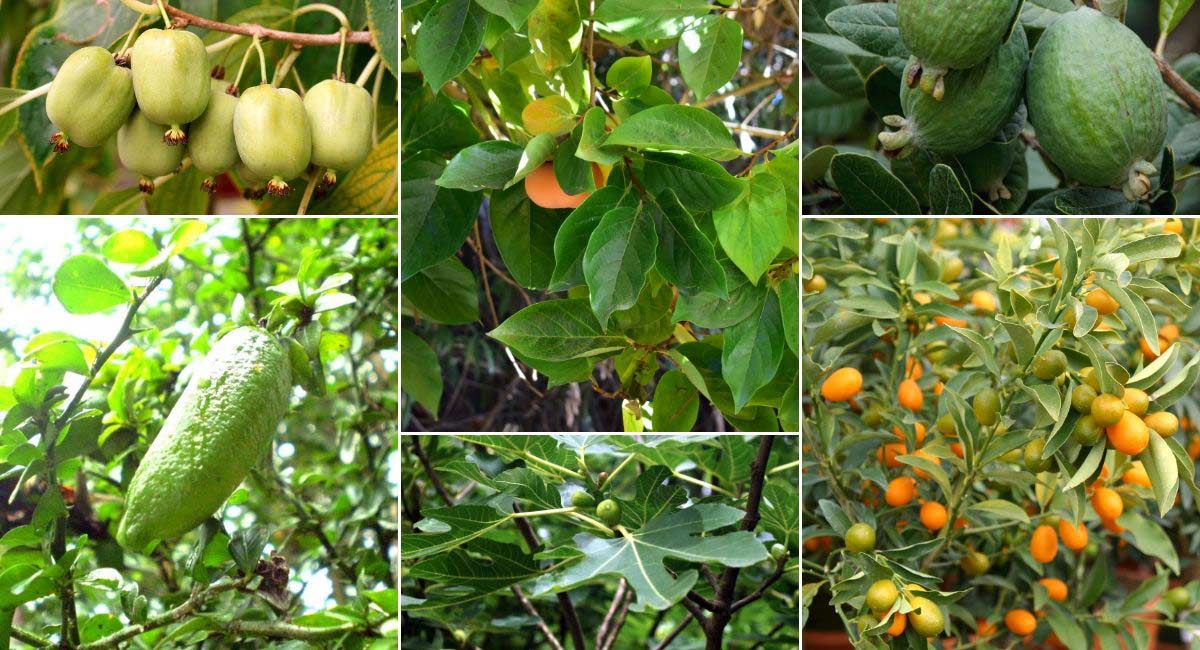
You can pair finger lime with other original fruit trees! Kiwai, finger lime, persimmon (photo Fastily), fig tree, feijoa (photo Jocelyn Kinghorn), and kumquat
In south of France, use finger lime to compose a Mediterranean-style garden. Plant, for example, alongside it some palms, lavenders, helianthemums, agaves, santolina… To accommodate them, create a rockery with a mineral-dominant palette. Be seduced by colourful flowering of oleanders or by superb silhouette of an olive tree. Also feel free to train a bougainvillea or a passionflower up house façade. You can also plant other citrus trees: lemon, orange, bitter orange…
Useful resources
Frequently asked questions
-
Can I bring a finger lime into a flat or house for the winter?
No — the air would be too warm and dry for it! When you bring it indoors in autumn, place it in a cold greenhouse or an unheated, well-lit conservatory where temperature does not exceed 10 °C. We then recommend taking it back outside in spring! It will prefer being outdoors rather than staying under cover all year round.
-
Leaves are turning yellow and falling! Why?
This may be due to excess moisture, which causes roots to rot, or conversely to lack of water. Check substrate moisture. Ensure pot has a hole in the base to allow excess water from watering to drain away, and that substrate is sufficiently free-draining so as not to suffocate roots. We recommend letting substrate dry briefly between waterings. If you have brought the Citron caviar indoors, it is possible that an atmosphere that is too warm and dry for it is causing leaves to drop.
-
My finger lime isn't fruiting! Why?
It may still be too young. From sowing, Citron caviar plants can take 10 to 15 years to produce their first fruits. When produced by grafting, expect to wait 3-4 years. Also check that conditions suit it: Citron caviar prefers rich, free-draining soil. Don't hesitate to apply fertiliser to feed it and encourage fruiting.
- Subscribe!
- Contents
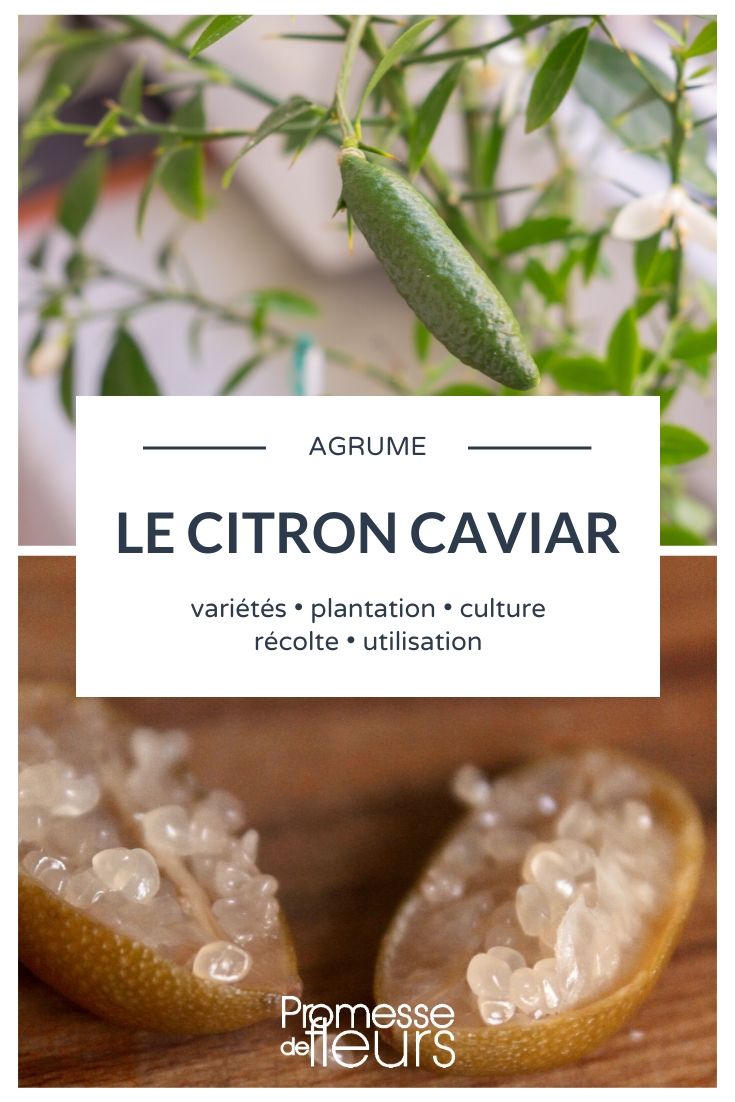


































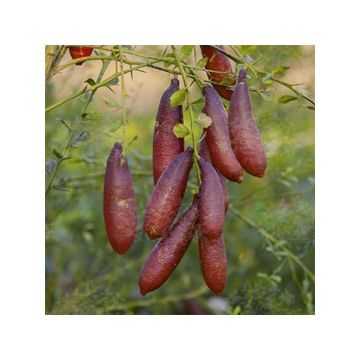
Comments